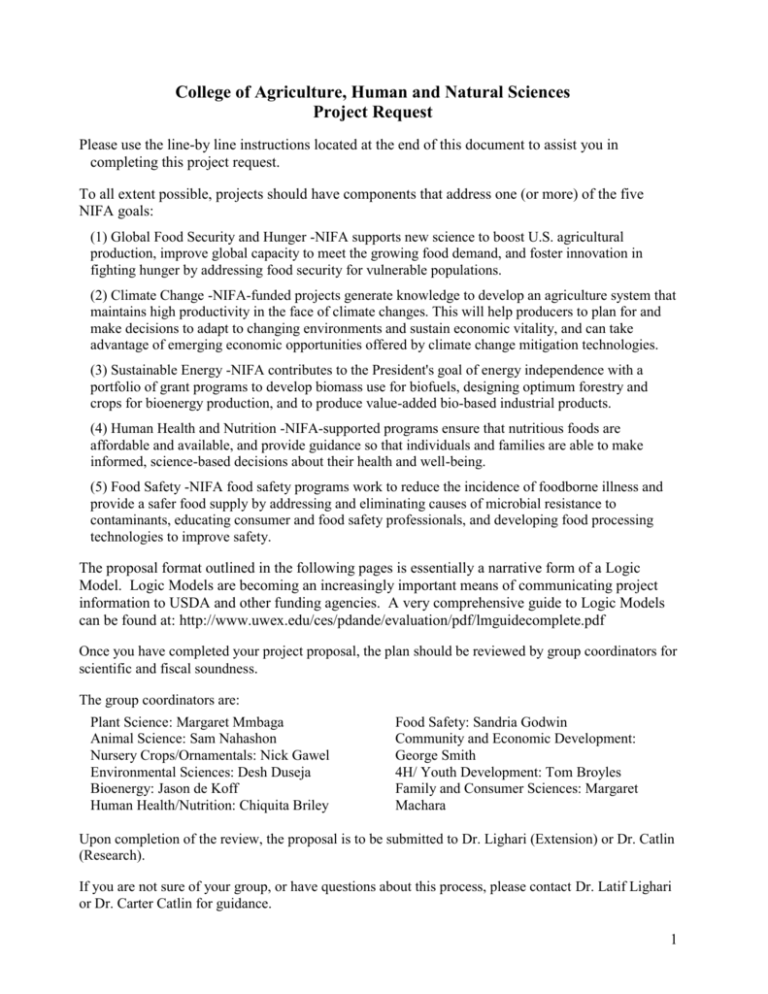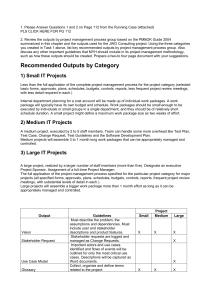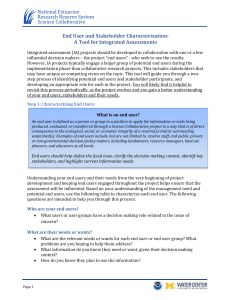1 -2 sentence mission statement for the project
advertisement

College of Agriculture, Human and Natural Sciences Project Request Please use the line-by line instructions located at the end of this document to assist you in completing this project request. To all extent possible, projects should have components that address one (or more) of the five NIFA goals: (1) Global Food Security and Hunger -NIFA supports new science to boost U.S. agricultural production, improve global capacity to meet the growing food demand, and foster innovation in fighting hunger by addressing food security for vulnerable populations. (2) Climate Change -NIFA-funded projects generate knowledge to develop an agriculture system that maintains high productivity in the face of climate changes. This will help producers to plan for and make decisions to adapt to changing environments and sustain economic vitality, and can take advantage of emerging economic opportunities offered by climate change mitigation technologies. (3) Sustainable Energy -NIFA contributes to the President's goal of energy independence with a portfolio of grant programs to develop biomass use for biofuels, designing optimum forestry and crops for bioenergy production, and to produce value-added bio-based industrial products. (4) Human Health and Nutrition -NIFA-supported programs ensure that nutritious foods are affordable and available, and provide guidance so that individuals and families are able to make informed, science-based decisions about their health and well-being. (5) Food Safety -NIFA food safety programs work to reduce the incidence of foodborne illness and provide a safer food supply by addressing and eliminating causes of microbial resistance to contaminants, educating consumer and food safety professionals, and developing food processing technologies to improve safety. The proposal format outlined in the following pages is essentially a narrative form of a Logic Model. Logic Models are becoming an increasingly important means of communicating project information to USDA and other funding agencies. A very comprehensive guide to Logic Models can be found at: http://www.uwex.edu/ces/pdande/evaluation/pdf/lmguidecomplete.pdf Once you have completed your project proposal, the plan should be reviewed by group coordinators for scientific and fiscal soundness. The group coordinators are: Plant Science: Margaret Mmbaga Animal Science: Sam Nahashon Nursery Crops/Ornamentals: Nick Gawel Environmental Sciences: Desh Duseja Bioenergy: Jason de Koff Human Health/Nutrition: Chiquita Briley Food Safety: Sandria Godwin Community and Economic Development: George Smith 4H/ Youth Development: Tom Broyles Family and Consumer Sciences: Margaret Machara Upon completion of the review, the proposal is to be submitted to Dr. Lighari (Extension) or Dr. Catlin (Research). If you are not sure of your group, or have questions about this process, please contact Dr. Latif Lighari or Dr. Carter Catlin for guidance. 1 College of Agriculture, Human and Natural Sciences Project Request 1. Project Title Title: Project Principal Investigator Percentage time allocation Research Extension 2. NIFA /CAHNS Goal Addressed (Check all that apply) Global Food Security and Hunger Plant Science Animal Science Climate Change Environmental Science Ornamental/ Nursery Crops Sustainable Energy Bioenergy Human Health and Nutrition Nutrition Food Safety 4H/Youth Leadership Community and Economic Development Family and Consumer Sciences 3. Executive Summary 1 4. Project participants Name Position Responsibilities/duties 5. Please supply a very brief (1 - 3 sentence) mission statement for the project Mission statement: 6. Project activities Summary: 7. Situation and priorities for the project, the project justification Situation/priorities (limit 1600 characters): 8. Program assumptions Assumptions (limit 1600 characters): 9. Procedures/methods to obtain desired outcomes and goals (materials and methods) Methods (limit 1600 characters): 10. Expected outputs – numbers of publications, factsheets, techniques, patents, cultivars, etc. Expected outputs Year 1 Year 2 Year 3 Publications Patents Factsheets Curricula Workshops Techniques Cultivars Other (specify) Generalized anticipated titles of publications, target characteristics of patents, objective of techniques, subject matter of curricula, subject of workshops, traits of cultivars, and descriptions of “Other” outputs specified above. 2 11. Extension outputs Direct Contacts Adults Indirect Contact Adults Direct Contact Youth Indirect contact Youth Year 1 Year 2 Year 3 12a. Outcome measures Year 1 Outcome type Change in Knowledge Change in Action Change in Condition Target number 12b. Outcome measures Year 2 Outcome type Change in Knowledge Change in Action Change in Condition Target number 12c. Outcome measures Year 3 Outcome type Change in Knowledge Change in Action Change in Condition Target number 3 13. External Factors External Factors: Natural disasters Economy Appropriation changes Public policy changes Government regulations Competing public priorities Competing programmatic challenges Population changes (immigration, new cultural groupings, etc.) Other (provide brief explanation) 14. How will the success of this project be measured and documented? Evaluation studies planned – check all that apply: After only (post program snapshot) Retrospective (post program review of entire program) Before-After (before and after program) During the program Time series (multiple points before and after the program) Case Study Comparison between program participants (individuals, organizations) and non-participants Comparison between different groups of individuals or program participants experiencing different levels of program intensity Comparison between locales where the program operates and sites without program intervention Other (provide brief explanation) 4 15. Evaluation Data Collection Methods Collection Methods (check all that apply): Sampling Whole Population Survey: Mail Telephone On-site Interview: Structured Unstructured Case Study Observation Portfolio Review Tests Journals Other (provide brief explanation) 16. What is the target audience for this project? Target audience 17. What actions were used to identify stakeholder individuals and groups for the project? Use advisory committees Use internal (within university) focus groups Use external (outside the university) focus groups Open listening sessions Needs assessments Use surveys Other (Please specify ) 5 18. What actions were used to seek stakeholder input for the project? Use of media to announce public meetings and listening sessions Targeted invitation to traditional stakeholder groups Targeted invitation to non-traditional stakeholder groups Targeted invitation to traditional stakeholder individuals Targeted invitation to non-traditional stakeholder individuals Targeted invitation to selected individuals from general public Survey of traditional stakeholder individuals Survey of general public Survey specifically with non-traditional groups Survey specifically with non-traditional individuals Survey of selected individuals form the general public Other (Please specify ) 19. How was the stakeholder input used in shaping the project objectives? In the budget process To identify emerging issues To redirect the research project In staff hiring process In action plans To set priorities Other (please specify) 20. How will the proposed project address the critical issues of strategic importance, including those identified by the stakeholders? 21. How will the proposed project address the needs of under-served and under-represented populations of the state and region? 22. How will the proposed project result in improved program effectiveness and/or efficiency? 6 23. Budget (see attached comment) FY 1 $ amount % time FY 2 $ amount % time FY 3 $ amount % time Personnel (Name) Supplies Equipment Total Equip. Travel Grand Total 24. Space requirements Person Office Lab G/house S/house Farm 25. Attach a resume listing, for the past five years, refereed journal articles, grants, and graduate students advised. For multi-institution grants, list TSU portion of funding. For graduate students, list role in advisement (committee member, committee chair). 7 Line by Line Instructions Item 1. Project Title A succinct title for your project. Project Principal Investigator Your name Percentage time allocation Percentage of your time being allocated to this project. Item 2. NIFA/CAHNS Goal Check all boxes that apply. One project may fit more than one goal. If more than one goal is covered, please provide a comment that states, in general terms, which parts of the project address which goal. Item 3. Executive Summary Include a 2-4 paragraph summary of the project: what problem is the project addressing, why is that problem important; how the problem will be addressed, expected impact of the project, how impact will be measured or quantified. Item 4. Project Participants Include the name, position, percentage of time allocated to project and general responsibilities of each project participant, including scientists, associates, assistants, and students. Students are expected to be included in each project. If a participant’s percent time is expected to change over the life of the project, make appropriate notations by year. Item 5. Mission Statement Enter a statement describing the ultimate goal(s) of the program. This statement should describe a goal that addresses, solves, or otherwise gainfully impacts the issues pertinent to the project. Examples: Development of oil crops for use to lower dependence on foreign oil. (Bioenergy) Obesity reduction via nutrition education – improve health by lowering weight via awareness of information on nutrition. (Childhood obesity) Item 6. Project activities Please enter a very brief description of the activities you are planning. Just a couple of sentences, phrases, or bullets will do. Activities are what we do. Examples of activities: - Conduct Research Experiments. - Construct Research Facilities. - Conduct Workshops, Meetings. 1 - Deliver Services. - Develop Products, Curriculum, Resources. - Provide Training. - Provide Counseling. Item 7. Situation and Priorities The situation is the foundation for logic model development. The issue that your program is to address sits within a setting or situation – a mixture of scientific, environmental, economic and political conditions. If you incorrectly assess the situation and misdiagnose the issue, everything that follows is likely to be ineffective. Take time to understand the situation and carefully define the issues, i.e., the problem that is to be solved, the needs to be met, the opportunity to be seized. As you do so, consider the following questions: What is the problem the project is addressing and why is it important? What is the issue? Why is it an issue? What is the need or opportunity? For whom (individual, household, group, community, society in general) does this issue exist? Who has a stake in the issue (who cares whether it is addressed or not)? What do we know about the issue/people involved? What research and experience is available? What do existing research and experience reveal about approaches that would work best? Space here is very limited, so choose phraseology carefully. Item 8. Program Assumptions Assumptions are the thoughts and ideas you have about your program, the people involved in the program, and the way you think the program will work. These assumptions are confirmed and corroborated with research and experience. Assumptions underlie and influence the program decisions you make. Assumptions are principles, beliefs, ideas about: - The issue or situation - The resources and staff - The way the program will operate - What the program expects to achieve - The knowledge base - The external environment - The internal environment - The participants: how they learn, their behavior, motivations, etc. To complete this part of the logic model, discuss briefly the assumptions you are making for the program. Good, clear assumptions demand knowledge of the literature or "best practice" in the research area, as well as "common sense". Consider the following: 2 Why do you believe that the program will work this way? Are your ideas and beliefs based on research, best practice, experience, local wisdom, intuition? Is there evidence that supports the theory of action you've laid out? Examples of assumptions: - Your understanding of key science areas in which work needs to be done to address problems/needs/opportunities. - How proposed efforts address research questions and fit into key science areas. - How proposed efforts fit together to solve problems. - Communities can form coalitions to address problems. - Funding will be secure throughout the course of the project. - Information exists on best practices in (whatever… ). - People will be motivated to learn/change. - External funds and agents can serve as catalysts for change. - Staff can be recruited and hired with necessary skills and abilities. Item 9. Procedures/methods to obtain desired outcomes and goals (materials and methods) What things will you do to accomplish the mission(s) in Item 5. Item 10. Expected Outputs This is a numerical projection of the papers, products and technologies the project will produce. Enter numbers in the table. Item 11. Extension Outputs This is the standard output measure for each program in Extension. Not required of research projects, but may be used in research projects if applicable. Item 12 a-c. Outcome Measures This is the all-important impact section. Impact can be defined as the change to society that is produced as a result of your activities; this is accomplished through outcome measures. Outcome measures are defined by you – they are the ways you have defined how you will measure the desired outcome of your project; for example: “Producers optimizing fertilizer use through measurement of soluble salts”. Outcomes differ from outputs in that outputs are the things you produced (papers, patents, etc.) outcomes are the changes you made happen (changes in knowledge, action, or condition). Please enter into these tables each of the planned outcome measures for each year of your project. Note that each outcome measure is asked to be defined as an impact that is a “Change in Knowledge”, “Change in Action” or “Change in Condition”. Enter the outcome measure description into the table's header, and then enter your target measures in the table as appropriate. In this example a “Change in Knowledge” measure might be "Number of participants gaining knowledge", a “Change in Action” measure might be "Number of persons adopting practice X", and a “Change in Condition” measure might be something like "Percent decrease in contaminant X in the environment". 3 Item 13. External Factors The environment in which your program exists contains a number of external factors that are beyond your control and that can influence the program's success. External factors include the cultural environment, the climate, economic structure, housing patterns, demographic patterns, political environment, background and experiences of program participants, media influence, changing policies and priorities. Item 14. Evaluation Factors As part of your plan for this program, NIFA asks for an indication of which methods you will use to evaluate your success in achieving your specified program outcomes. How will you measure what you have done? What tool will you use to determine if you have met the goals? Item 16. Targeted Audience Please enter into this text box a very brief description of the targeted audience for your program. Examples include: - pesticide producers - extension educators - commercial producers - youth aged 13-18 - economists - homeowners - policy makers Items 17-19. Check appropriate boxes. Items 20-22. Include one or two bullet points or brief sentences to illustrate how the project addressed each question. Item 23. Budget Provide budgetary information by fiscal year. List salaries for each person separately, include base salary and benefits (Base + 33%) in the amount listed. All persons on the project should be listed, including technical and student employees. Students should be included in each project. Allowable salary percentages are: Assistant Professor (Less than 3 years of employment): 100% Assistant Professor (Three or more years of employment): 90% Associate Professor: 80% Full Professor: 70% Itemize equipment purchase costs by year. If there are other items needed, or special explanations needed, please explain on a separate sheet. 4 Item 24. Space requirements Please list the space required for the entire project. For laboratory space, indicate room number and percent of the space utilized by this project. For greenhouse and shade house space indicate the location (N= Nashville, M= McMinnville) and amount of area needed; if this area will change over the life of project, indicate area by year. Farm space should be designated by location (N = Nashville, M= McMinnville, C= Cheatham County), type (field, goat pen, etc.) and area; again, if the area needed will change during the life of the project, indicate area by year. 5








